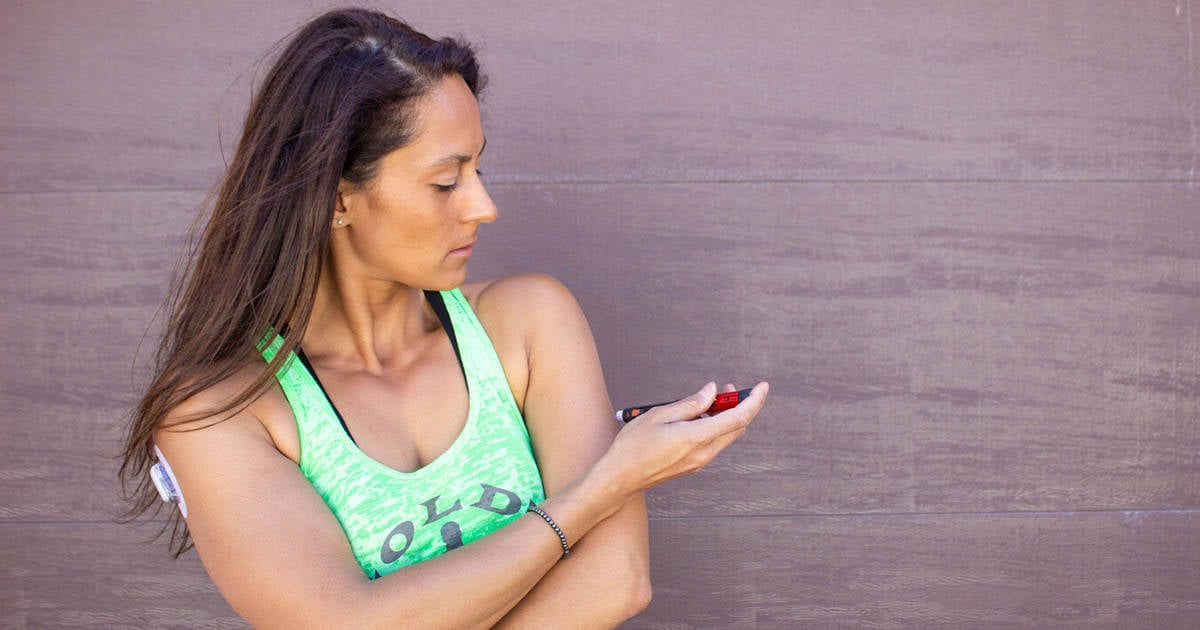Do you live with insulin-dependent diabetes, count your carbs accurately, but still struggle with postprandial (after meal) high or low blood sugars?
If so, your “insulin-to-carb ratio” may need adjustment.
Your insulin-to-carb ratio is a number that tells you how much rapid-acting insulin you need to cover a specific amount of carbohydrates. It’s what allows you to accurately dose insulin for meals or to correct high blood sugars.
In this post, I will cover what your insulin-to-carb ratio is, how to find yours, factors that can influence it, and the available tools and mobile apps that can help you find and keep track of your ratios.
If your doctor is the one changing your insulin-to-carb ratios, a lot of the information we’ll discuss in this post will be relevant to bring to your doctor so that he or she can make informed changes to your diabetes management.

What is an insulin-to-carb ratio and why does it matter?
Your insulin-to-carb ratio (also just called a “carb ratio” or “carb factor”) indicates how many grams of carbs one unit of rapid-acting insulin covers to ensure that your blood sugars stay in your desired range.
Your carb ratio is often initially set by your doctor when you are diagnosed but should be updated regularly (if needed). A carb ratio of 1:10 means that 1 unit of rapid-acting insulin will cover 10 grams of carbs. A higher ratio indicates that you need less insulin to cover your carbs.
Let me give you an example:
If my carb ratio is 1:10 and I’m eating 30 grams of carbs, I’ll need 3 units of rapid-acting insulin to cover the meal (30 divided by 10). However, if my carb ratio is 1:15 I’ll only need 2 units of rapid-acting insulin (30 divided by 15)
That a higher carb ratio means less insulin can take a little time to wrap your head around but it’s an important fact when you start adjusting your carb ratio(s).
If you time the peak of your insulin with your meal, an accurate carb count combined with an accurate carb ratio will mean that your blood sugar should stay within your desired range and below 180 mg/dl (10 mmol/L).
If the timing of your insulin for the meal is off, but your carb count and carb ratio is right, you might see your blood sugar go slightly out of range but it should be back in range within 90 minutes (which is the average time insulin peaks.)
It’s also important to note that you should subtract the fiber content in your meal from your total carb count before calculating your insulin dose because fiber doesn’t break down completely in your digestive system and therefore does not raise blood sugar levels. Dosing for fiber could lead to low blood sugar.
How to calculate your carb ratio(s)
If you suspect that your carb ratio is off (often running high or low after meals could be a good indicator of that), it’s time to collect data in the form of blood sugar readings and do some analysis.
If you want good results you need good data, and you’re the only one who can collect it. As with most other things related to diabetes, it requires work but it’s worth it.
I suggest following the 4 steps below for 3-5 days minimum to collect data for you or your doctor to assess whether your carb ratio is correct. If you and/or your doctor don’t see any trends after 3-5 days, you’ll have to collect more blood sugar data.
- Focus on one meal at a time (breakfast for example). Try to enjoy the meal at roughly the same time each day and eat the same foods and quantities for the data collection period (this is why breakfast is a good place to start as it is easier to eat the same thing for breakfast each day)
- Make sure your carb count is correct and stick with the same carb ratio for the data collection period
- Try not to do anything that impacts your blood sugar significantly right before or after the meal (like going for a run)
- Be on top of your blood sugar measurements or Continuous Glucose Monitor (CGM)
- Measure your blood sugar before the meal
- Measure your blood sugar after the meal (90-120 minutes after your injection)
After 3-5 days, you should have enough data to start assessing whether your carb ratio for this time of day is accurate.
When you or your doctor does the analysis, you’ll focus on whether your blood sugar was in your desired range before the meal and whether your blood sugar came back into your desired range within 90-120 minutes of your insulin injection.
Note: I try not to take correction insulin doses when testing my carb ratios since it makes it harder to assess whether the carb ratio is accurate, but if your blood sugars are dangerously high or just higher than you’d like them to be, then go ahead and correct. You can always continue your carb ratio experiment another day. Always safety first!!
Let’s look at 2 different scenarios, assuming a meal of 30 carbs (that’s counted as accurately as possible) and a starting carb ratio of 1:10.
Blood sugar in-range before the meal, but high 90-120 minutes after
If your blood sugar is not back in range or coming down quickly 90-120 minutes after your meal, your carb ratio is too high. You can consider trying to experiment with ratios below 1:10, maybe 1:9 or 1:8 is the right ratio for you.
I don’t like to change my ratios too drastically since I’d rather run a little high for a few days than end up with a nasty low blood sugar. Remember, the lower the carb ratio, the more insulin you need per gram of carbs.
Blood sugar in-range before the meal, but low 90-120 minutes after
If your blood sugar is lower than your target range 90-120 minutes after your meal, your carb ratio is too low. You can consider trying to experiment with ratios higher than 1:10, maybe you need to go to 1:11 or 1:12. As mentioned, I usually do small incremental changes.
You also need to consider if your timing for when you take your insulin is off. If you have low blood sugar within 30-60 minutes of your injection, your food might not have been sufficiently digested yet and will hit your bloodstream later. You can assess this by measuring your blood sugar frequently and experimenting with taking your insulin a little later.
Note: The carb ratios listed here are just examples. You can have ratios much higher or lower than 1:10.
Things that influence your carb ratios
Our bodies change over time and so do our eating and exercise patterns. As your body and daily routine change, you might find that your carb ratio(s) needs to be adjusted.
Here are 5 things that can influence your carb ratios:
Time of day
You might have noticed that I write “carb ratio(s)” because most people have more than one carb ratio. For example, many are more insulin resistant in the morning so they might need a lower carb ratio for breakfast than they do for lunch or dinner.
In theory, you can have as many carb ratios as you like, but most diabetes devices (pumps, apps, smartpens) have a limited number. Mine has 4 and I utilize the 3. I have my lowest ratio for breakfast and the highest ratio for dinner and overnight.
Time of month (for women)
The fluctuating hormone levels of your menstruation cycle can have a significant impact on your blood sugars and your insulin needs. This can mean that you need different carb ratios (and most likely basal insulin) for periods where you’re extra insulin resistant due to hormonal changes.
I’m one of those women who see large differences in my insulin needs throughout my cycle. I need significantly less insulin the day(s) right before my period and always need to increase my carb ratios.
Type of meal: the impact of protein & fat
Carbs might be what’s converted into glucose in the bloodstream the fastest, but it’s not the only macronutrient that can impact your blood sugar.
If you eat large amounts of protein, you’ll most likely need to inject insulin to not see an increase in your blood sugar.
If you add large amounts of fat to your meal, you’ll most likely see a delayed release of the glucose into your bloodstream, which for many people means that they need to take two insulin doses rather than just one (one with the meal and one some time later).
Exercise/movement
If you’re more or less active than normal, you should consider that when you calculate your insulin doses. If you take your bolus insulin 30-60 minutes before a workout, you often need to reduce your dose by 25-75 percent. That’s a huge range and you’ll need to find the right reduction for you.
It’s worth mentioning that if you do resistance training or interval training, you might not need a reduction, you might even need an increase as these types of workouts can make blood sugars increase.
Bodyweight
If your body weight changes significantly, you’ll most likely see that your insulin needs change as well.
If your body fat percentage increases significantly, you might experience that you need more insulin to cover your meals. If you gain a significant amount of muscle mass, on the other hand, you might see that you need less insulin to cover your meals.
Tools to help you find and remember your carb ratios
Using carb ratios is pretty straightforward if you use an insulin pump to manage your diabetes. Most pumps have a built-in bolus calculator (calculates your suggested dose) and your medical team should have set it up for you and trained you on how to use it. If that’s the case, you just need to focus on whether your ratios are accurate.
If you manage your diabetes with manual injections, you need to look elsewhere for a “carb calculator” or memorize or write down your ratio(s). The benefit of a good calculator is that it can keep track of active insulin (insulin lasts 3-5 hours in the body) and can help keep track of your injections and ratio(s).
Mobile apps: There are no FDA-approved standalone apps that are approved for dosing recommendations in the United States, but I have used RapidCalc (not FDA-approved) and found it to be accurate and easy to use.
Outside of the United States, good options are the Hedia and MySugr apps.
Smart insulin pens: Companion Medical’s InPen is a smartpen available in the US only. It has all the functionalities of a pump, except for actually pumping, so it automatically keeps track of active insulin and has a bolus calculator. It sends the data directly to your phone via Bluetooth.
Smart meters: Some blood glucose meters also have bolus calculator functionalities or have an app that links with the meter.
Don’t expect perfection!
I know this post may have given you a lot to think about – and possibly work on. I recommend starting small and including your medical team as much as you need to.
A good place to start could be your breakfast carb ratio. Once you think you have that down, you can move on to lunch, then dinner, and then snacks.
And you won’t always get it right. We don’t have full information on what’s going on in our bodies and some days, your usual ratios won’t work. That doesn’t mean that they’re not right for you, give it a few days to see if things return to normal.
But if you keep experiencing high or low blood sugars after meals, it might be time to tweak your insulin-to-carb ratios.




mary lynn drul
i am a 75 year old lady. morbidly obese. i am type 2. when my sugar test shows 15 how many units of fast acting should i take. and if this is not right after a meal, just gone high can i take some then as well. i am confused. dr says one thing and home care says another. i would take 0 units at least. just a guess . these are Canadian numbers
Christel Oerum
Only your medical team can advise when it comes to insulin dosing. You want to ask them about your correction factor and carb ratios and how to use them
John Joseph
Hello,
I was diagnosed at 49 years of age as LADA. I’ve always been overly concerned about my health and safety, so the thought of going low is very unsettling. My first year as a diabetic was very difficult for me because I never knew if I’d produce insulin on my own and go low (I’ve had several unpredictable situations). Now that my pancreas has completely stopped producing insulin, I still have a difficult time pre-bolusing for fear I’ll go low. How do I get over the fear of going low?
Christel Oerum
That fear of lows is based on experience and it will take some time to work through that. You might benefit from working with a mental health professional that understands diabetes (the American Diabetes Association has a directory you can find here: https://professional.diabetes.org/mhp_listing).
If that’s not for you, I would try to document when you take insulin and what happens. That way you might be able to see, in your own data, what pre-bolusing does for you. This might be easier if you have a CGM, but if you don’t, try measuring blood sugars right before, 30-min later, 1 hour later, etc. I’ve found that experience, and seeing what happens to my own blood sugars have helped build confidence
M M
Hi,
My ICR is 8. So in other words I need to divide total amount of carbs eaten at a single time by 8. If I do not take the required amount of insulin to cover the carbs, will my body not absorb the protein I have eaten as well?
Any thoughts on this would be greatly appreciated!
Thanks!
Christel Oerum
If you have no insulin on board at all your body won’t be able to take in the nutrition from anything you eat. Generally, when it comes to protein you will need to dose for it if you eat very large amounts or if the meal is very low carb. So, if you inject less insulin than you need for the meal, your body won’t take in all of the nutrition coming from everything in your meal, protein, fat, and carbs
David John Keohane
Hello Christel,
I hve been diabetic for over 40 yrs and hve experienced 6 early warning hypo signs phases.
That said, I am now going through a new phenomena.
I start intensive exercise at 5.30am and this routine Mon-Fri does’nt stop until 8.30am
Then again 2.20pm – 6.30pm.
I hve lost (5pounds) Oct 21 to Jan 22?
Fisap intake post eve meal results in a low BG 1hr later continuing to decrease until verging hypo.
Then the level increases resulting in high bloods.
My ratio 1:10 seems too much
So if I convert to 1:15 would this reduce the problem?
Christel Oerum
That post low high could possibly be the Somogyi effect https://diabetesstrong.com/somogyi-effect/
Increasing your carb ratio as you suggest would mean less insulin for the meals and would lower the risk of lows. I don’t know if 1:15 will fix the issue or if you need to do 1:20 or more, that’s something you, and if you need him/her, your doctor would have to experiment with.
I generally reduce my insulin before and after exercise especially long-duration exercise like what you describe and keep my other ratios lower (lower = more insulin)